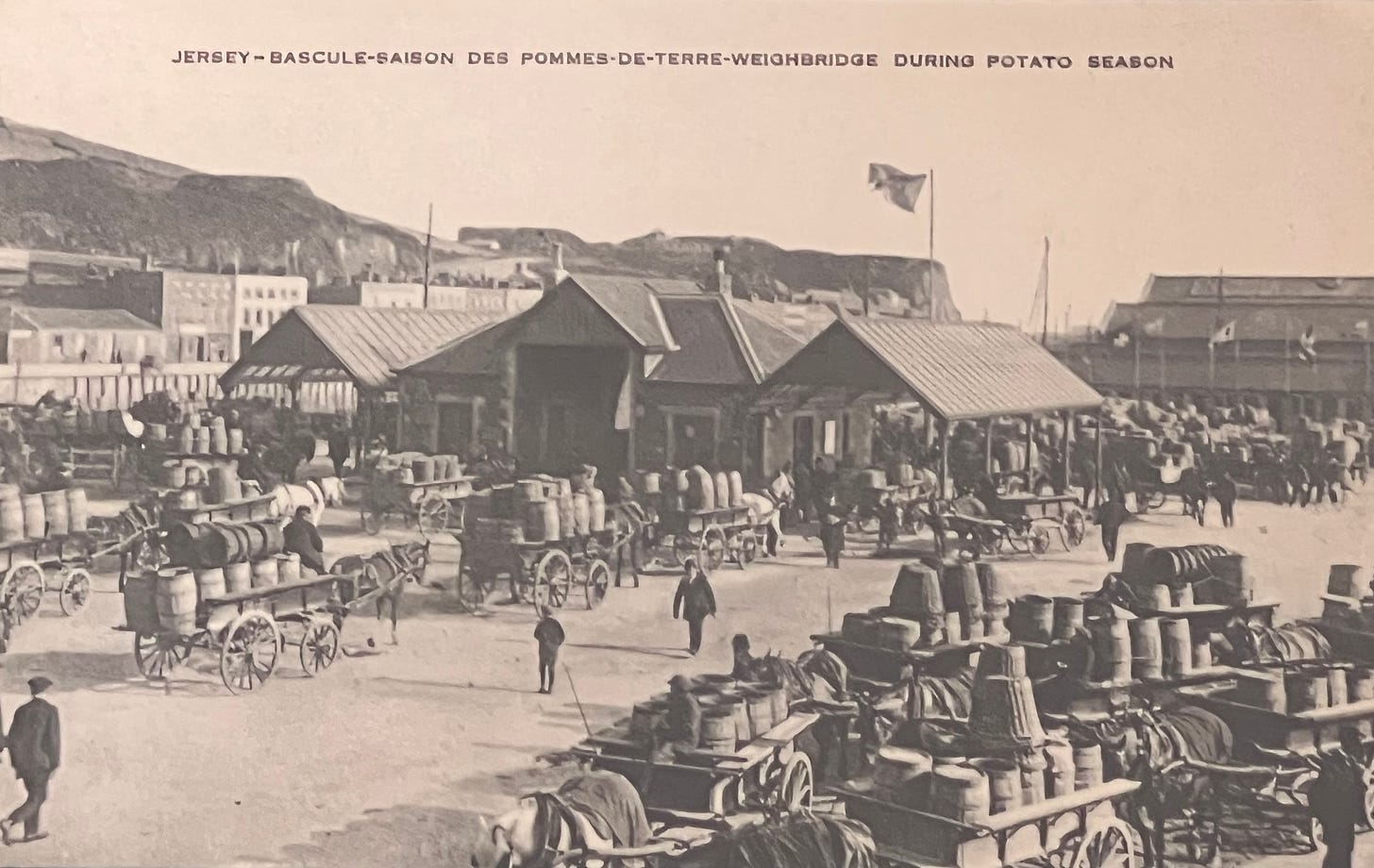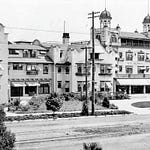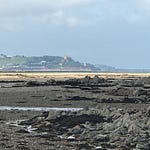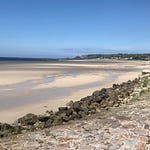If you stand exactly where you are and slip 120 years back in time, what would you see? This idea was the inspiration for the short video above. The Weighbridge, once adorned by its great statue of Queen Victoria, was for many years the Island’s commercial hub. In peak potato season, it was a bustling hive of activity.
In later decades the area was repurposed as a bus station, the statue was moved beside the Grand Hotel, and the Esplanade’s shoreline advanced to conquer the bay. Today, with the advent of high-rise apartments and the new International Finance Centre, the view is utterly transformed from its Edwardian heyday.
A decade ago, I tried to capture its original atmosphere when I was writing about Charlie Chaplin’s visit to Jersey in Jersey: The Hidden Histories. He passed through in August 1912 to perform in Mumming Birds at the Opera House. I imagine Chaplin telling the story in his own words:
“I sleep late the next day. Pretty little Jersey feels a world away from the dazzling metropolitan theatres, or the drinking pits of south London. The air here is salt-heavy and beguiling, reminding me of one lost boyhood day, before the fall, when we joyously dipped our toes in the sea at Southend-on-Sea. I never saw the sea again as a child. St Helier is even more delightful, though for all its French airs it is branded with the hallmarks of British provincialism. A grand statue of Queen Victoria dominates the Weighbridge, her heavy shadow still hanging like an implacable burden over our age. Little engines trundle out from the nearby railway station, creeping westwards along the arc of the bay. The wooden warehouses that line the Esplanade are packed high in season with potatoes for export for the finest markets in London.
Tomorrow is the climax of the Battle of Flowers, a charming parade that since the late King Edward’s coronation has formed the mainstay of the summer season here. The weather has been rather foul in these parts of late, but we can hardly miss the chance to take part in such a celebration. At a loose end that afternoon, my cast members and I join the parade on Victoria Avenue, marching in unison as a theatre troupe to amuse the crowds of assorted onlookers and good-timers.
They are still putting the finishing touches to the Battle displays, great floral barges, lavish flower-sacrifices to the gods of fate and summer and chance. I prance past the floats in character, drolly reprising my role as the tipsy music hall buffoon. The people love it. I break out from the line and perform an impromptu performance. Staggering past, clowning and japing it up to high heaven, I draw titters and cheers from the audience. I drink in the applause.
Out of the corner of my eye, a man is cranking up one of those curious new-fangled marvels, a cinematographic camera for taking motion pictures. It am told he has come down from London for the purpose, at the behest of the Topical Gazette, and is grinding his machine for all its worth. Almost many people seem to be watching him as me. I love novelty, and this is my first time on film, but it seems to fit me like a glove. The crowds roar out their acclaim, and the sea air is fresh with the scent of opportunity.
My little solo escapade is coming to an end. I bow jauntily and revel in the cheers. Just as I saunter back into the mêlée, I spy a little boy, his face dirty and smudged, gazing at me with pure adoration. I look back at him and see myself. He is a grimy street urchin, dirty but clinging to his pride, entranced by the show. The boy calls out to a distant mother, “Oh mamma, why has he gone away? I did want to see the funny man again?” His laughter burns in my ears like a promise.
In that moment, I begin to understand. This is the shape of things to come. The cine-camera whirrs and turns, spinning out my future. Suddenly the sun breaks in through the cloud bank high over St Aubin’s Bay, and hangs above the horizon like a glorious sign. The 1912 Battle of Flowers glides on. The little lost boy turns and smiles at me for one last time, before he is swallowed up by the carnival. I slip back into the warm embrace of the parade, my ears ringing with his laughter, dancing on towards tomorrow”.
You might be interested to know that Discover Britain magazine has a fantastic Channel Islands special edition out now (August/September 2024 edition, issue 241). It includes a contribution from me on Jersey’s culture and identity. The magazine is available across the UK and Channel Islands.
~ Paul Darroch
Finally, the music in the video is “Sunset Drive” by Future Joust, courtesy of Epidemic Sound. This felt like a very appropriate 1980s-style synth soundtrack for a spot of time travel!












